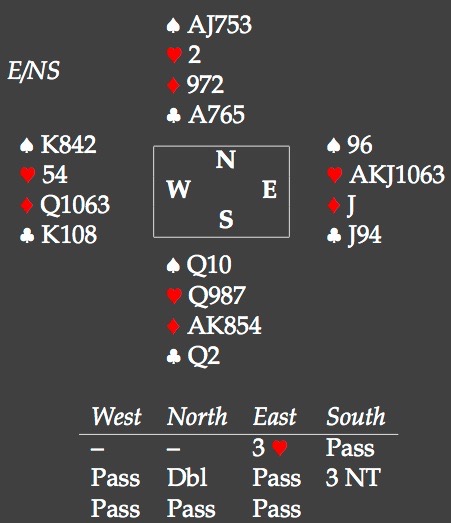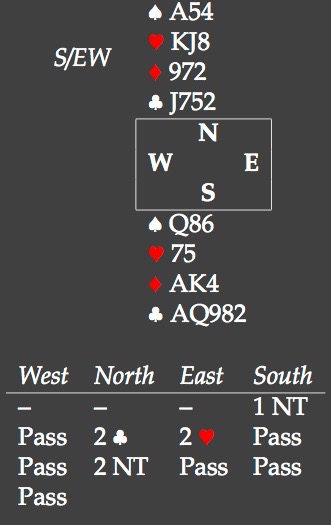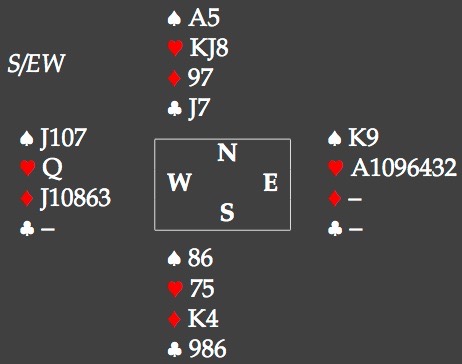 Back to bridge, the summer breaks in the various bridge events are almost over, time to warm up the bridge skills for the winter season in a local duplicate. More people needed to warm up, look at this hand played by one of my opponents.
Back to bridge, the summer breaks in the various bridge events are almost over, time to warm up the bridge skills for the winter season in a local duplicate. More people needed to warm up, look at this hand played by one of my opponents.
 West leads the ♥5, ♥2, ♥10 and you?
West leads the ♥5, ♥2, ♥10 and you?
It looks tempting to win the trick, but you really shouldn’t. Why? East may have preempted on a 6 card suit like ♥AKJTxx. If you now have to lose a spade trick, or try to set up a diamond, west will still have a heart and EW can cash their heart tricks. Of course, all this doesn’t matter when the ♥K is offside or when east has 7 hearts, but otherwise it is the difference between making and going down.
At our table, south took the first trick, played the spades, then tried to set up a diamond. EW still had their communication and declarer duly went down. Looking at the full diagram, you’ll see that there are lots of ways to make the contract.
Eliminating side suits, then giving up the lead, forcing the opponents to break open a suit is standard technique amongst advance players. Almost all cases, involve a trump suit, as the ruff and sluff is an essential part of the play. Yet, eliminations and endplays in NT do exist. Look at this hand from the same duplicate.

You end up in 2NT and get a somewhat surprising lead of the ♦Q. The contract doesn’t look that attractive. The diamond lead suggests a decent suit in south. It also suggest that south isn’t too pleased about his heart holding and afraid that leading one would give up a trick. One or two small, perhaps. Of course this will change after he has seen the dummy. You could play all-in, by winning, crossing to the ♣A and taking a club finesse. If it wins, you have your 8 tricks. If it fails, you will be in a lot of trouble though: heart back through the ♥KJ, spade back through the queen, and another heart. It isn’t that hard to imagine a layout where you end up down lots.
As this is matchpoints, it is always good to look at alternative contracts and how they would do. First, NS can bid some number of clubs. In a club contract, they lose a spade, 2 hearts and a diamond, plus any club loser they may have. The maximum score in that contract will thus be about +110. The number of tricks in a heart contract is harder to estimate, but assuming ♥AQ10xxx in north (and 2 small in south), plus a black king offside, will result in about 7 tricks. In 2♥, that translates to +100 for your side. If they can make more, fine, if they go down more, there is little you can do about it, so don’t bother.
Your goal is to beat those scores: 2♥, down 1, +100 or 3♣, making 3, +110. How do you do that? Well, by playing for at least 8 tricks and minimizing the chances that you go down.
With that in mind, you decide to play the ♣A and a ♣. If north wins, you have given up a club trick, but you still have the hand under control. If south wins, you have much more control over the hand than you would have playing ♣A and a club finesse.
East wins the second round of clubs, both sides following, so the finesse was right, and you have given up a trick. East isn’t too pleased winning the trick though and takes a lot of time to consider her next move. This is not unexpected, she has the strong hearts and is unwilling to lead away from those, no more clubs, and probably no more diamonds either. If she had one, she would probably return one right away. After a minute or so, a small spade is returned.
The break in tempo strongly suggests that she has some unattractive spade holding, after all, with a holding of, say, ♠JT9, a spade return is kind of obvious. You go up with the ♠Q and this wins the trick, west contributing the ♠2. The position now being something like this:
 Now the stage is set for a rare elimination play in NT. You cash the remaining diamonds and clubs, then play ♠A and a spade. East wins and is forced to give at least 1 trick to the dummy. In practice, she got it wrong (♥A and a heart, instead of a small heart), but 9 tricks would also have been a good score too, see below.
Now the stage is set for a rare elimination play in NT. You cash the remaining diamonds and clubs, then play ♠A and a spade. East wins and is forced to give at least 1 trick to the dummy. In practice, she got it wrong (♥A and a heart, instead of a small heart), but 9 tricks would also have been a good score too, see below.
Could EW have done something better. Yes, at various obvious points and also it would have been a lot clearer to play the ♠J on the spade return. That suggests the ♠!0 and east can now pitch her ♠K at some point. The endplay won’t work as west can win the spade and play a heart. Declarer still has 8 tricks though.
All this work results in 10 tricks, that must be a good score?
No, when you enter the score, you see that most EW pairs bid a lot more hearts than just 2♥. Without anything useful in dummy, they went down lots of tricks, and half the NS pairs picked up +200 to +1100. In clubs, the best people did was 9 tricks in 3♣ (+110), sometimes bidding higher or taking less tricks.
You were the only player in NT. The simple line of a spade to the ace and a club finesse would have given you 8 tricks, for +120, beating all the club contracts and losing to all the heart contracts, for about an average score. Your score of +180 also beats those club contracts but still loses to the heart contracts, so you get exactly the same average score.
Operation successful, patient dead as doornail.
